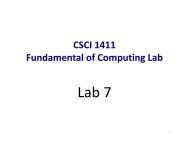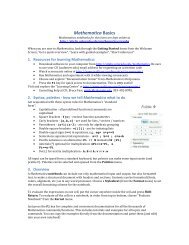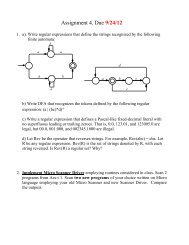[PDF] The Thickness and Chromatic Number of r - Gammeter.com
[PDF] The Thickness and Chromatic Number of r - Gammeter.com
[PDF] The Thickness and Chromatic Number of r - Gammeter.com
You also want an ePaper? Increase the reach of your titles
YUMPU automatically turns print PDFs into web optimized ePapers that Google loves.
<strong>of</strong> the index labels <strong>of</strong> the subdivision vertices will yield r − 1 more planar layers <strong>of</strong><br />
an edge de<strong>com</strong>position for K1,n[2r].<br />
Consider any edge ℓi <strong>of</strong> the given matching <strong>of</strong> K1,n[2]. Subdivide ℓi with 2r − 2<br />
vertices, which together with the endpoints <strong>of</strong> ℓi, induces a path <strong>of</strong> length 2r − 1. In<br />
preparation for the use Lemma 1 we label these 2r vertices by<br />
v1, v2r, v2, v2r−1, . . . , vi, v2r−(i−1), vi+1, . . . , vr, vr+1.<br />
Similarly, take the edge CenterEdge <strong>and</strong> subdivide it with 2r − 2 vertices. Label the<br />
vertices <strong>of</strong> the resulting path <strong>of</strong> length 2r − 1 in linear order by<br />
c1, c2r, c2, c2r−1, . . . , ci, c2r−(i−1), ci+1, . . . , cr, cr+1.<br />
Suppose the endpoints <strong>of</strong> the center-most edge <strong>of</strong> subdivided CenterEdge are x<br />
<strong>and</strong> y. (<strong>The</strong> vertices x <strong>and</strong> y are <strong>of</strong> the form ci <strong>and</strong> cj, the indices are known, differ<br />
depending on whether r is odd or even, <strong>and</strong> are unimportant for now.) Transform<br />
K1,n[2] further by adding edges {xvj : j = 2, . . . , r}∪ {xvj : j = r + 1, . . . , 2r}∪<br />
{yvj : j = 2, . . . , r}∪ {yvj : j = r + 1, . . . , 2r}. <strong>The</strong> resulting graph, denoted by T1,<br />
is planar; see Figure 8 (c).<br />
To achieve r − 1 additional planar layers, we permute the vertex labels <strong>of</strong> T1.<br />
Specifically, for i = 2, . . . , r, define Ti to be the graph obtained by adding i − 1<br />
(mod 2r) to the index <strong>of</strong> each vertex in T1. Observe that by design Ti is isomorphic<br />
to T1 for i = 1, . . . , r, which means that each Ti is planar.<br />
Penultimately, to see why Θ(K1,n[2r]) ≤ r, it suffices to show that K1,n[2r] ⊂<br />
� r<br />
i=1 Ti. By Lemma 1 we know that the construction accounts for all the edges <strong>of</strong><br />
the K2r induced by each leaf vertex in K1,n. Moreover, by Corollary 7 the endpoints<br />
<strong>of</strong> the center-most edge <strong>of</strong> the subdivision <strong>of</strong> CenterEdge together with all <strong>of</strong> the<br />
corresponding endpoints in the vertex-permuted graphs Ti for i = 1, . . . , r − 1 induce<br />
a perfect matching <strong>of</strong> the K2r induced by the vertex <strong>of</strong> degree n in K1,n. Hence,<br />
every vertex in this K2r is adjacent to all <strong>of</strong> the inflations <strong>of</strong> leaf vertices in K1,n[2r].<br />
Thus K1,n[2r] ⊂ � r<br />
i=1 Ti, which is what we needed to show.<br />
Finally, since any tree T is an edge disjoint union <strong>of</strong> stars, we may construct an<br />
edge de<strong>com</strong>position <strong>of</strong> T [2r] into r planar graphs as follows. Let Star 1 ∪ · · · ∪ Star q<br />
be a star de<strong>com</strong>position <strong>of</strong> T . Note that since T is a tree, two distinct stars Star i<br />
<strong>and</strong> Star j intersect in at most one vertex. Moreover, this de<strong>com</strong>position can be<br />
arranged so that if Star i <strong>and</strong> Star j do share a vertex ℓ, then ℓ is the center vertex <strong>of</strong><br />
Star i <strong>and</strong> a leaf vertex <strong>of</strong> Star j. Suppose that Star j[2r] has been de<strong>com</strong>posed into r<br />
planar graphs as described in the first part <strong>of</strong> this pro<strong>of</strong>. In Star j[2r], leaf vertex ℓ is<br />
transformed into a path, say ℓ ′ , with 2r vertices. Let x <strong>and</strong> y be the endpoints <strong>of</strong> the<br />
17


![[PDF] The Thickness and Chromatic Number of r - Gammeter.com](https://img.yumpu.com/3978766/17/500x640/pdf-the-thickness-and-chromatic-number-of-r-gammetercom.jpg)





